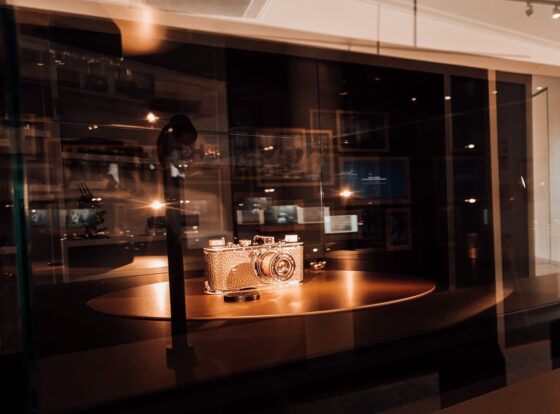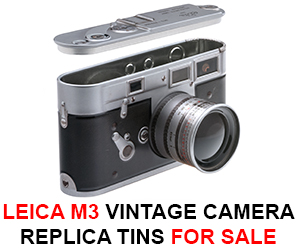
The Ernst Leitz Museum in Wetzlar is open again . Additional information:
ERNST LEITZ MUSEUM CELEBRATES REOPENING
The Ernst Leitz Museum in Leitz-Park Wetzlar, the home of the Leica Camera, is celebrating its reopening. After the completion of extensive alterations based on an innovative and interactive museum concept, a modern museum of photography is now ready to open its doors to visitors from 1 October and enrich the region with another fascinating attraction.
With a floor space of around 600 square metres on the upper floor, the Ernst Leitz Museum offers four newly designed experience zones that inspire visitors to see, get creative with and interactively experience photography. In addition to this, an exhibition space on the ground floor will present exhibitions of outstanding photography by internationally acclaimed artists. Until 24 October 2021, visitors can view ‘The Eyes of Humanity’, the successful and extremely popular exhibition showing a personal selection from the works of world famous Magnum photographer Steve McCurry from the past 40 years.
As a special highlight to celebrate the reopening, visitors will be able to see a true rarity among the exhibits: an original Leica 0-Series camera (No. 105), with which Oskar Barnack, the constructor of the Ur-Leica, had taken photographs. The Leica 0-Series cameras, of which only around a dozen have survived until today (and very few of them in unaltered original condition), are among the most desirable of all collectable cameras and achieve record prices at auctions of photographica, most recently at the Leitz Photographica Auction in Vienna in 2018. The Leica 0-Series camera (No. 122) was sold for an astronomical 2.4 million euros including the buyer’s premium, and is currently the world’s most expensive camera of all time. The Leica 0-Series camera from a private collection (No. 105) can be seen only at the Ernst Leitz Museum until the end of the year.
The four experience zones of the Ernst Leitz Museum, the concepts and realisation of which are the work of studio klv (Berlin), are divided into the areas ‘Seeing and Perception’, ‘Technology und History’, ‘Photography’ and a special exhibition. Interactive stations demonstrate optical phenomena and explain the basic principles of photography and the effect of various camera and lens settings in clear and simple terms. A prominent photographer (including Steve McCurry, Ralph Gibson, Barbara Klemm, Franziska Stünkel, Alex Webb and Fred Mortagne) accompanies each of the themed presentations, for instance reflections or motion, with an appropriate personal statement and a selected photograph relevant to the topic. Visitors can try out all the various photo settings and realise their own creative ideas with the Leica cameras integrated in the stations or their own smartphones and download all pictures and selfies they take with the Leitz-Park App and take them home with them as a souvenir.
Seeing and Perception
In the foyer of the Ernst Leitz Museum, the focus is on ‘Seeing and Perception’, and aims to sensibilise visitors to conscious perception of the world around them. Optical phenomena are explained in clear and simple terms. One of the visual aids to this can be seen, for example, on the large panoramic window of the museum – the iris of a Leica S Camera enlarged to fifty times its original size that opens and closes when visitors walk up to it. In addition, there are a range of frames with filters, colours and lines that illustrate the principles of photographic composition and inspire visitors to realise their own ideas.
Technology and History
The second zone, ‘Technology and History’, is dedicated to the long and eventful history of the legendary company, its innovations, craftsmanship and product milestones. Bronze busts portray the key figures of the Leitz family whose engagement and dedication to photography influenced and shaped the company. The proof that Leica played a decisive role in the development of photography can be seen in the cabinets with original, historic items. A digitally-enhanced window enables visitors to take a look into the Leica corporate archive and see highlights and milestones of the company’s history. In addition, interactive stations offer exciting ways to discover the outstanding technical features of Leica cameras and lenses – for example, by constructing a lens and following the rays of light passing through it in a real-time simulation, or by identifying and matching pairs of Leica cameras by means of an acoustic memory containing the unique sound signatures of their shutters. One of the other stations replicates a darkroom. On a large interactive table, visitors can recreate the steps involved in developing analogue photographs and, for example, develop and enlarge pictures from the Leitz-Park App.
Photography
In the third experience zone, various interactive stations enable visitors to discover more about the basic principles of photography and the how a range of different factors can influence the outcome of the photos they take. Photo settings for various situations invite them to experiment with the Leica cameras installed at the stations or their own mobile phones. Staged effects such as reflections, highlights and shadows, colour moods, motion and wind offer opportunities for capturing unusual photos and illustrate the fascinating opportunities and facets of creative visualisation. One exhibit is dedicated to the ‘Self-portrait’: Here, visitors can sit before a mirror, control the colour and intensity of the lighting and capture a self-portrait. The pictures taken here can then be downloaded with the Leitz-Park App and taken home as a souvenir.
Special exhibitions
In the fourth zone, visitors will find constantly changing special exhibitions with exhibits reflecting a diversity of topics from the world of Leica. The opening of the museum will be accompanied by an exhibition titled ‘Oskar Barnack’. Enriched with exhibits from the Leica corporate archive and pictures captured by the passionate photographer and film maker, this zone ideally complements the unique experience of photography in the new Ernst Leitz Museum.
The Ernst Leitz Museum in Leitz Park Wetzlar is open Monday to Sunday from 10 a.m. to 6 p.m. Further information can be found at: www.ernst-leitz-museum.de
About the Leica 0-Series
In 1913/1914, Oskar Barnacks construction of the legendary Ur-Leica paved the way for the enduring success of the 35 mm (or full-frame) format that is still common today, and laid the foundation for the short-run production of the prototypes of the Leica Camera, the 0-Series. The 0-Series cameras with the serial numbers 100-130 were produced in the years 1923 and 1924. While the first models stayed in the Leitz family, the original file cards in the Leica archive show that cameras No. 105 and No. 112 went to Oskar Barnack. The ownership-history of camera No. 105 of the Leica 0-Series can be verified from a number of letters. According to these, the model was always owned by a family, until it was loaned to the Deutsche Museum in Munich and subsequently found its way into the hand of collectors in the 1960s. Collectors of photographica agree that of the almost a dozen Leica 0-Series cameras known to exist are in the hands of collectors or in museums. It is probable, however, that not even a half of these models are in original condition.
Ernst Leitz Museum lets you experience photography interactively
Leica and Fotografiska partner to bring photography back to life in New York City
















